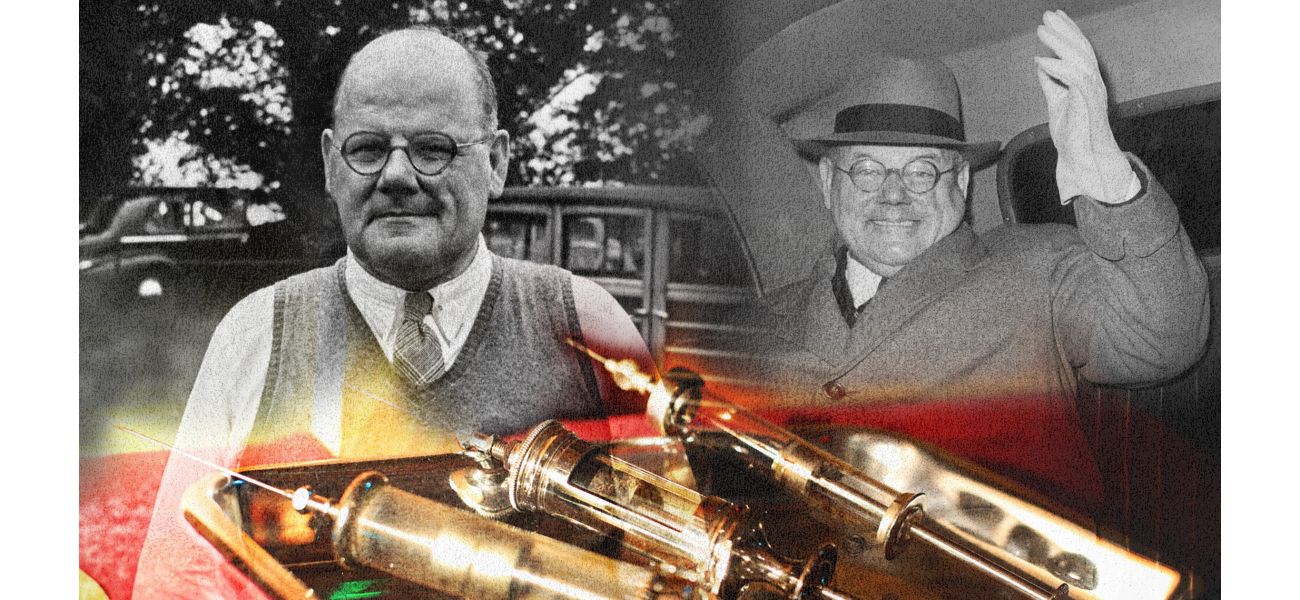Doctor found not guilty despite 163 patient deaths.
A 'charming' physician concealed a big hidden truth.
October 14th 2024.

John Bodkin Adams was more than just a doctor - he was a man with a complicated past and a controversial reputation. Despite his conviction for fraud and suspicions of being a serial killer, he was ultimately acquitted and continued to live and work in East Sussex, England. Decades have passed since his trial, but the case is still a topic of debate, with opinions divided on his true character.
Local curator Joel Griggs, who runs the True Crime Museum in Hastings, Sussex, has seen firsthand the conflicting views on Adams. Some people view him as "the scum of the earth," while others praise him for adding years to their loved ones' lives. Griggs often speaks about Adams at care homes, where the opinions are similarly divided. "The truth about Adams' character probably lies somewhere down the middle," he says.
Newspaper headlines at the time were filled with sensational stories of how Adams targeted elderly, wealthy women in the seaside town of Eastbourne. But behind the headlines was a man with a complex background. Born in Northern Ireland, Adams moved to Sussex to practice medicine after studying at Queen's University in Belfast. His charming Irish personality and round, rosy cheeks made him popular among high-ranking members of society, who often sought his services.
However, it wasn't just his personality that attracted patients to Adams. He was known for his round-the-clock availability, often attending to patients at all hours of the day and night. This made him particularly appealing to those who worked in London and couldn't see a doctor during regular business hours. As a result, he treated notable figures such as the Duke of Devonshire and former Prime Minister Theresa May's father, Reverend Hubert Brasier.
But while his practice may have been modest, Adams' lifestyle was anything but. He was known for his thrifty ways, often refusing to spend money on repairs and instead using unconventional items, like an old trouser belt, to fix his belongings. Despite this, he could often be seen driving around East Sussex in a luxurious chauffeur-driven Rolls Royce, a clear sign of his growing wealth.
Adams' wealth was not the only thing that raised suspicion. Between 1946 and 1956, an unusually high number of his patients had died while in comas. Even more concerning, 132 of those patients had left him money or items in their wills. It wasn't until respected musician Leslie Henson raised concerns about the death of his friend Gertrude Hullett, who had been treated by Adams, that the police began to investigate.
The police discovered a pattern of suspicious deaths among Adams' patients and built a strong case against him. He was eventually arrested for the murder of 81-year-old Edith Morrell, who had left him a box of expensive silver cutlery and a Rolls Royce in her will. Along with her murder, Adams was also charged with the death of Gertrude Hullett, but that case was later dropped.
Despite the evidence against him, Adams was ultimately acquitted of all charges. The trial had sparked intense debate and controversy, with many questioning whether the law had allowed a guilty man to walk free. Decades later, Adams' case is still a source of fascination and debate. But one thing is for sure - the charming doctor with rosy cheeks will always be remembered as one of the most enigmatic figures in British history.
John Bodkin Adams was a well-known general practitioner (GP) in the seaside town of Eastbourne, England. He was not only respected for his medical skills, but also admired for his charm and kind demeanor. However, behind this façade lay a dark secret – Adams was a convicted fraudster and suspected serial killer.
The trial of Doctor Adams in 1957 caused quite a stir, with many people following the case closely. The judge, Lord Justice Patrick Devlin, even remarked that sometimes the law allows the guilty to walk free. This was a shocking statement, especially considering the overwhelming evidence against Adams.
Numerous patients had died under Adams’ care, most of whom were wealthy women. What was even more suspicious was that many of them had changed their wills to include Adams as a beneficiary. Despite the concerns raised by their families, Adams was ultimately acquitted of his crimes and continued to practice medicine in East Sussex.
Decades have passed since the trial, but the case is still a subject of intense debate. Some people still believe that Adams was a cold-blooded killer, while others maintain that he was a kind and compassionate doctor. Joel Griggs, the curator of the True Crime Museum in Hastings, Sussex, shares that even in the local community, opinions about Adams are divided. Some see him as the scum of the earth, while others remember him fondly for adding years to their loved ones' lives.
The truth about Adams’ character probably lies somewhere in the middle. He was known for being a charming Irishman, with his rosy cheeks and gift of the gab. His patients, who were mostly wealthy and high-ranking members of society, were enamored by his bedside manner. He even treated the Duke of Devonshire, a former minister, and the father of former Prime Minister Theresa May.
Despite his humble practice, Adams lived a lavish lifestyle, often spotted riding around in a chauffeur-driven Rolls Royce. However, his wealth was a mystery, and his thrifty ways, such as borrowing pens and pocketing nice glasses, raised eyebrows.
But it wasn't just his lifestyle that was suspicious – a series of mysterious deaths also surrounded Adams. Patients would unexpectedly fall into a coma and then pass away, leaving behind wills that benefited the GP. Between 1946 and 1956, 163 of Adams’ patients died under these circumstances, and 132 of them had left him money or possessions in their wills.
It was the death of Gertrude Hullett, a close friend of famous musician Leslie Henson, that first raised concerns about Adams. Henson contacted the police, and an investigation was launched. The detectives soon discovered that most of the patients who died under Adams' care were elderly women, many of them widows.
Adams was finally arrested in 1956, and the police believed they had a strong case against him. He was charged with the murder of Edith Morrell, who had left him a box of expensive silver cutlery and a Rolls Royce in her will. The 81-year-old had died six years earlier, and her family was convinced that Adams had given her a lethal dose of drugs. The doctor was also charged with the death of Gertrude Hullett, but this case was later dropped.
Today, needles used by Adams are on display at the True Crime Museum, serving as a reminder of the dark chapter in Eastbourne's history. The case of John Bodkin Adams may have ended in acquittal, but the jury is still out for many people, and his true character remains a mystery.
Local curator Joel Griggs, who runs the True Crime Museum in Hastings, Sussex, has seen firsthand the conflicting views on Adams. Some people view him as "the scum of the earth," while others praise him for adding years to their loved ones' lives. Griggs often speaks about Adams at care homes, where the opinions are similarly divided. "The truth about Adams' character probably lies somewhere down the middle," he says.
Newspaper headlines at the time were filled with sensational stories of how Adams targeted elderly, wealthy women in the seaside town of Eastbourne. But behind the headlines was a man with a complex background. Born in Northern Ireland, Adams moved to Sussex to practice medicine after studying at Queen's University in Belfast. His charming Irish personality and round, rosy cheeks made him popular among high-ranking members of society, who often sought his services.
However, it wasn't just his personality that attracted patients to Adams. He was known for his round-the-clock availability, often attending to patients at all hours of the day and night. This made him particularly appealing to those who worked in London and couldn't see a doctor during regular business hours. As a result, he treated notable figures such as the Duke of Devonshire and former Prime Minister Theresa May's father, Reverend Hubert Brasier.
But while his practice may have been modest, Adams' lifestyle was anything but. He was known for his thrifty ways, often refusing to spend money on repairs and instead using unconventional items, like an old trouser belt, to fix his belongings. Despite this, he could often be seen driving around East Sussex in a luxurious chauffeur-driven Rolls Royce, a clear sign of his growing wealth.
Adams' wealth was not the only thing that raised suspicion. Between 1946 and 1956, an unusually high number of his patients had died while in comas. Even more concerning, 132 of those patients had left him money or items in their wills. It wasn't until respected musician Leslie Henson raised concerns about the death of his friend Gertrude Hullett, who had been treated by Adams, that the police began to investigate.
The police discovered a pattern of suspicious deaths among Adams' patients and built a strong case against him. He was eventually arrested for the murder of 81-year-old Edith Morrell, who had left him a box of expensive silver cutlery and a Rolls Royce in her will. Along with her murder, Adams was also charged with the death of Gertrude Hullett, but that case was later dropped.
Despite the evidence against him, Adams was ultimately acquitted of all charges. The trial had sparked intense debate and controversy, with many questioning whether the law had allowed a guilty man to walk free. Decades later, Adams' case is still a source of fascination and debate. But one thing is for sure - the charming doctor with rosy cheeks will always be remembered as one of the most enigmatic figures in British history.
John Bodkin Adams was a well-known general practitioner (GP) in the seaside town of Eastbourne, England. He was not only respected for his medical skills, but also admired for his charm and kind demeanor. However, behind this façade lay a dark secret – Adams was a convicted fraudster and suspected serial killer.
The trial of Doctor Adams in 1957 caused quite a stir, with many people following the case closely. The judge, Lord Justice Patrick Devlin, even remarked that sometimes the law allows the guilty to walk free. This was a shocking statement, especially considering the overwhelming evidence against Adams.
Numerous patients had died under Adams’ care, most of whom were wealthy women. What was even more suspicious was that many of them had changed their wills to include Adams as a beneficiary. Despite the concerns raised by their families, Adams was ultimately acquitted of his crimes and continued to practice medicine in East Sussex.
Decades have passed since the trial, but the case is still a subject of intense debate. Some people still believe that Adams was a cold-blooded killer, while others maintain that he was a kind and compassionate doctor. Joel Griggs, the curator of the True Crime Museum in Hastings, Sussex, shares that even in the local community, opinions about Adams are divided. Some see him as the scum of the earth, while others remember him fondly for adding years to their loved ones' lives.
The truth about Adams’ character probably lies somewhere in the middle. He was known for being a charming Irishman, with his rosy cheeks and gift of the gab. His patients, who were mostly wealthy and high-ranking members of society, were enamored by his bedside manner. He even treated the Duke of Devonshire, a former minister, and the father of former Prime Minister Theresa May.
Despite his humble practice, Adams lived a lavish lifestyle, often spotted riding around in a chauffeur-driven Rolls Royce. However, his wealth was a mystery, and his thrifty ways, such as borrowing pens and pocketing nice glasses, raised eyebrows.
But it wasn't just his lifestyle that was suspicious – a series of mysterious deaths also surrounded Adams. Patients would unexpectedly fall into a coma and then pass away, leaving behind wills that benefited the GP. Between 1946 and 1956, 163 of Adams’ patients died under these circumstances, and 132 of them had left him money or possessions in their wills.
It was the death of Gertrude Hullett, a close friend of famous musician Leslie Henson, that first raised concerns about Adams. Henson contacted the police, and an investigation was launched. The detectives soon discovered that most of the patients who died under Adams' care were elderly women, many of them widows.
Adams was finally arrested in 1956, and the police believed they had a strong case against him. He was charged with the murder of Edith Morrell, who had left him a box of expensive silver cutlery and a Rolls Royce in her will. The 81-year-old had died six years earlier, and her family was convinced that Adams had given her a lethal dose of drugs. The doctor was also charged with the death of Gertrude Hullett, but this case was later dropped.
Today, needles used by Adams are on display at the True Crime Museum, serving as a reminder of the dark chapter in Eastbourne's history. The case of John Bodkin Adams may have ended in acquittal, but the jury is still out for many people, and his true character remains a mystery.
[This article has been trending online recently and has been generated with AI. Your feed is customized.]
[Generative AI is experimental.]
0
0
Submit Comment





